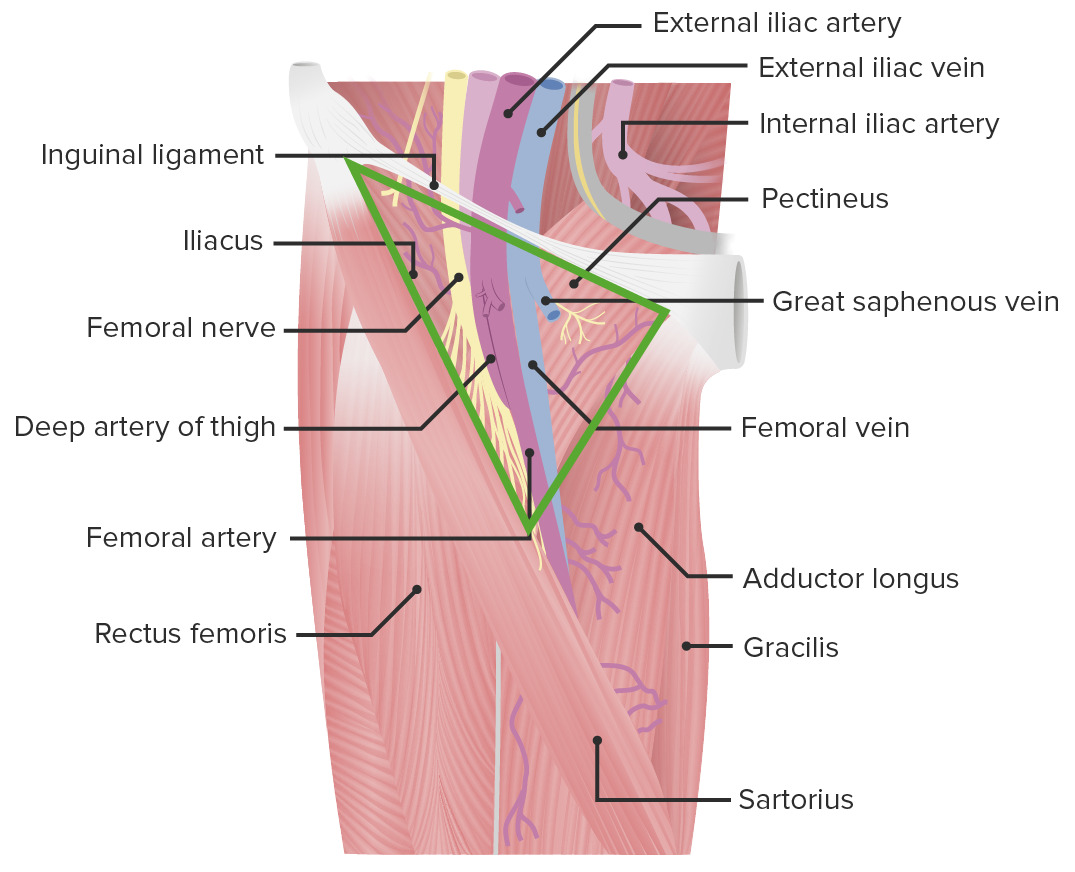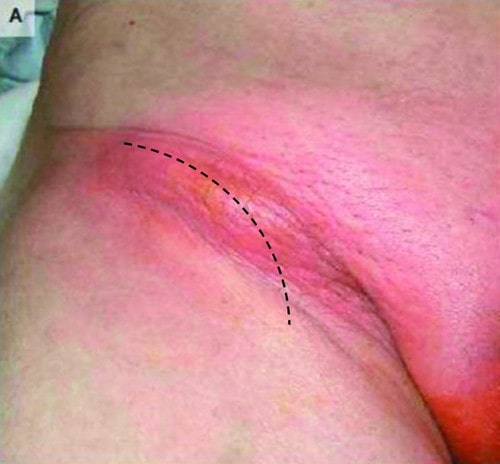A femoral hernia Hernia Protrusion of tissue, structure, or part of an organ through the bone, muscular tissue, or the membrane by which it is normally contained. Hernia may involve tissues such as the abdominal wall or the respiratory diaphragm. Hernias may be internal, external, congenital, or acquired. Abdominal Hernias is an uncommon type of groin Groin The external junctural region between the lower part of the abdomen and the thigh. Male Genitourinary Examination hernia Hernia Protrusion of tissue, structure, or part of an organ through the bone, muscular tissue, or the membrane by which it is normally contained. Hernia may involve tissues such as the abdominal wall or the respiratory diaphragm. Hernias may be internal, external, congenital, or acquired. Abdominal Hernias in which intra-abdominal contents herniate under the inguinal ligament and through the femoral ring into the femoral canal. More common in adults than in children, femoral hernias usually present with swelling Swelling Inflammation that protrudes into the femoral triangle (inferiorly to the inguinal ligament and medial to the femoral vein). Although uncommon, femoral hernias are frequently associated with complications, secondary to the small size of the canal, leading to hernia Hernia Protrusion of tissue, structure, or part of an organ through the bone, muscular tissue, or the membrane by which it is normally contained. Hernia may involve tissues such as the abdominal wall or the respiratory diaphragm. Hernias may be internal, external, congenital, or acquired. Abdominal Hernias incarceration Incarceration Inguinal Canal: Anatomy and Hernias and/or strangulation Strangulation Inguinal Canal: Anatomy and Hernias.
Last updated: Nov 19, 2024
The femoral ring is the proximal or abdominal/pelvic opening of the femoral canal.
Boundaries:

Boundaries of the femoral ring and canal in relation to the femoral vessels and nerve
Image by Lecturio.The femoral canal is a cylindrical space, making up the medial compartment enclosed within the femoral sheath.

Closeup of the femoral triangle featuring the location of the femoral canal in relation to the neighboring structures of the inner thigh
Image by Lecturio.The femoral triangle is located on the medial aspect of the anterior thigh Thigh The thigh is the region of the lower limb found between the hip and the knee joint. There is a single bone in the thigh called the femur, which is surrounded by large muscles grouped into 3 fascial compartments. Thigh: Anatomy.

Anterior view of the thigh, featuring the femoral triangle
Image by Lecturio.
Anterior view of the thigh, featuring the femoral triangle with its borders and contents
Image by Lecturio.The femoral hernia Hernia Protrusion of tissue, structure, or part of an organ through the bone, muscular tissue, or the membrane by which it is normally contained. Hernia may involve tissues such as the abdominal wall or the respiratory diaphragm. Hernias may be internal, external, congenital, or acquired. Abdominal Hernias is the protrusion of intra-abdominal contents under the inguinal ligament, through the femoral ring, and into the femoral canal, producing a “bulge” or swelling Swelling Inflammation in the femoral triangle.

Closeup of the femoral triangle featuring the location of a femoral hernia
Image by Lecturio.To remember the borders of the femoral triangle—SAIL:
To remember the contents of the femoral triangle (from lateral to medial)—NAVEL:

Preoperative frontal view of a patient with a femoral hernia that demonstrates a red, round bulge in the groin area. The black dotted line shows how the curved low inguinal incision was performed.
Image: “De Garengeot’s hernia in a 60-year-old woman: a case report. ” by Konofaos P, Spartalis E, Smirnis A, Kontzoglou K, Kouraklis G. License: CC BY 2.0Depending on the location and contents of the protrusion, several subtypes of femoral hernias have been described:

Types of femoral hernias
Image by Lecturio.
Schematic diagram of the difference in location between direct inguinal hernias, indirect inguinal hernias, and femoral hernias
Image by Lecturio.
Ultrasonography of an incarcerated femoral hernia showing the oedematous hernia sac, above the femoral vessels
Image: “Incarcerated femoral hernia containing ipsilateral fallopian tube” by Atmatzidis S, Chatzimavroudis G, Dragoumis D, Atmatzidis K. License: CC BY 3.0
Schematic diagram of the management options for femoral hernias, depending on their state of reducibility.
Image by Lecturio.Femoral vascular access: The femoral artery and vein are easily accessed within the femoral triangle for interventional procedures.
The following conditions are included in the differential diagnoses of femoral hernias: